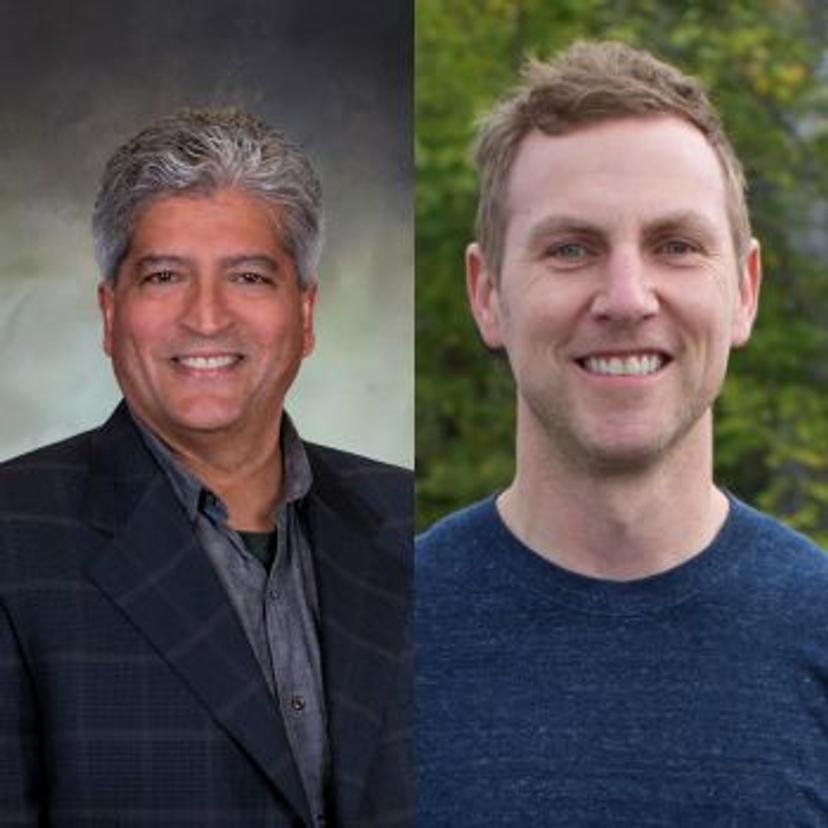Cancer research and trends in cell therapy treatments
Experts discuss how to navigate the frontier of cell and gene therapy for the treatment of cancer
5 Sept 2023

In this Q&A discussion, Jai Balkissoon, M.D., FACS, global vice president, head cell and gene therapy, medical science and strategy, clinical research business, Thermo Fisher Scientific, and Evan Zynda, Ph.D, Sr. Staff Scientist, Thermo Fisher Scientific, highlight the key trends and challenges in cell and gene therapy. Plus, they explore the latest advancements in cell therapy for cancer treatment.
What makes cell and gene therapy trials so complex and how do you address the challenges that are associated with these trials?
Jai Balkissoon: The complexities start from the fact that we are using living cells to treat diseases. These cells may come from normal heathy donors, cord blood or the patients themselves through apheresis. The manufacturing and genetic engineering that make these “living drugs” target specific diseases can be quite complex.
At the PPD clinical research business of Thermo Fisher Scientific, we have supported more than 160 immuno-oncology studies, which includes 137 in cell and gene therapy (CGT) across a wide range of tumor types and therapeutic areas. We have been successful in managing the coordination of cell harvesting, manufacturing, shipping back to sites and patient safety for these complex trials. The time from apheresis to manufacturing with gene modifications and the return to sites for infusion – also called “vein to vein” time – can be long, and some patients may require “bridging” therapy while they wait for their cells to be manufactured. Delays in manufacturing can prevent some patients from receiving these innovative therapies.
Adoptive cell therapies are usually given as a single infusion and the expectation is that these cells will persist in the patient for a prolonged period. This allows continued antitumor activity with durable responses and the potential for cure. Allogeneic, or off-the-shelf cell therapies, can alleviate some of the challenges associated with autologous cell therapies. With these allogeneic treatments, there is no need for patients to undergo apheresis and cells are readily available to infuse into multiple patients without manufacturing delays. Some off-the-shelf cell therapies can be given as multiple infusions per cycle, which may improve antitumor activity with more durable responses.
What are some of the important challenges with the current development of cell therapies in hematology/oncology?
Jai Balkissoon: The first challenge is to identify, train and qualify non-traditional research-experienced sites to be able to run clinical trials with cell therapies in their community and treat patients there with currently approved therapies. This involves a collaborative commitment between cell therapy-experienced clinical research organizations (CROs), sponsors, academic sites, payers and regulators. It is important to develop cell therapy education programs that are dedicated to supporting the training of new research-experienced community sites that are motivated, committed and have the resources to become CGT-experienced sites. These research-experienced community sites also should be able to become certified by the Foundation for the Accreditation of Cellular Therapy (FACT) to be fully accredited to treat patients with cell therapies.
As the demand for promising cell therapies continues to increase, we will need additional research-experienced community sites to run cell therapy studies. Academic cell therapy institutions can offer programs where community oncologists and other site staff – such as research nurses, study coordinators and pharmacists – can attend on-site training sessions that ultimately benefit community hospitals. Finally, community sites will need to have assurance from insurance carriers that they will be reimbursed for approved comparator arm treatments, as well as for approved cell therapy treatments.
A second challenge is preventing and managing the toxicities that have been associated with cell therapies. For autologous cell therapies, the most important toxicities that we are all familiar with are cytokine release syndrome (CRS) and neurotoxicity, or ICANS, seen with CAR-T cell treatments. Although the majority are grade one and two, it is the potential for the higher-grade toxicities that may occur more than 14 days after infusion that has fueled our conservative practices to monitor patients closely, often in the hospital for seven days followed by the requirement for patients to remain in the local vicinity of the study site for one month after infusion of CAR-T cells. We need to design better and safer cell therapies with fewer toxicities, while identifying biomarkers that can predict early onset of toxicities and which patients are more likely to develop severe life-threatening toxicities. We can then develop risk-mitigation strategies and prophylactic measures that may prevent or decrease the severity of these toxicities. The potential for severe and sometimes life-threatening toxicities has prevented these advanced cell therapies from being used by community oncologists.
How does your team stay prepared and up to date on the latest information regarding cell and gene therapies? Why is this important to your clients?
Jai Balkissoon: We have a specialized training program through our Adoptive Cell Therapy (ACT) Academy, which ensures all clinical research associates (CRAs) and project teams are adequately prepared to manage immuno-oncology and cell therapy trials. This includes self-paced training modules through our Learning Management System, which take approximately 12 hours to complete and lead to a pass/fail assessment upon completion. In addition, our CGT Institute offers cross-functional expertise in hematology/oncology and includes physicians conversant in CAR-T, as well as investigators and key opinion leaders at the top of their field.
Our clients and sponsors appreciate this comprehensive training program and our commitment to ensuring that project teams are appropriately trained in immuno-oncology and CGTs.
What have been the most impactful innovations or advancements related to cancer therapies?
Evan Zynda: One of the most significant advances in the ongoing fight against cancer has been the development of cellular immunotherapies, which harness the inherent power of the patients’ own immune cells to identify and kill abnormal cells. Several such cell therapies have now been approved for the treatment of various hematological malignancies, including lymphomas, leukemias and multiple myeloma. To date, the vast majority of these approved “living drugs” are autologous T cell therapies and are produced by collecting the patients’ T cells, a type of white blood cell, and re-engineering them to express chimeric antigen receptors (CARs) on their surface. CARs are designed to recognize antigens that are specific to cancer cells, thereby marking these cells for cytotoxic targets. As an approved treatment option, CAR-T cell therapies are relatively new with Novartis’ KYMRIAH (tisagenlecleucel) being the first such therapy to receive FDA approval in August 2017. Now, there are seven FDA approved CAR-T drugs on the market, and while this is a major milestone in the history of cell therapy, these CAR-T drugs only cover a small percentage of global unmet medical needs.
As could be expected, the immense promise of these therapies has been accompanied by many growing pains. Going forward, some of the most prominent challenges associated with these highly innovative treatments include simplifying the complicated manufacturing processes, improving efficacy for solid tumors, lowering high production costs and ensuring patient safety.
What are the major trends in cell therapy making cancer treatments more accessible?
Evan Zynda: To address the aforementioned challenges, the industry is moving toward completely closed and automated workflows consisting of scalable and flexible solutions cloaked in immunological knowledge. By closing and automating everything, clinical manufacturers can reduce both the need for expensive and highly trained niche labor and the potential incidence of failure modes. In addition to closed operation and automation, devices and reagents that can be applied to a wide range of scales will be well-positioned to accommodate the entire spectrum of autologous and allogeneic therapies that aim to overcome the cell therapy accessibility hurdles through different modalities. Along these same lines, it is also important to keep in mind that the field of cell therapy is still relatively new and there is no standardized workflow. As such, there is high demand for products that can readily adapt to the infinite number of processes that are being developed and employed to manufacture these treatments. Modular devices increase the stepwise flexibility and thoughtfully designed reagents allow more freedom for varying timings and compatibility of steps, as well as application of alternative cell types. All of this increased elasticity in workflow design can not only simplify manufacturing, but could also yield improved patient outcomes as we continue to learn more about the makeup of efficacious cells and modify the process in a way that encourages improved cellular outputs. These efforts advance the proliferation of cell therapy modality for cancer treatment and help save more lives.
You mentioned that cell therapies have shown promising results mainly for patients diagnosed with blood cancers. What’s needed for cell therapies to deliver equal efficacy for solid tumor cancers?
Jai Balkissoon: We expect to see more CGT clinical trials in patients with solid tumors. Currently, many cell therapy cancer trials are conducted in patients with hematologic malignancies where there is usually one specific tumor-associated antigen to target. Cell therapy trials in solid tumors are more complex and have been hampered by the heterogeneity of tumor-associated antigens, lack of antigen specificity and overlap of antigens between tumors and healthy tissues, as well as the significant immune suppression found within the tumor microenvironment – all of which can increase certain toxicities.
Although there are significant challenges, the number of cell therapy trials in solid tumors is expected to increase and new cell therapy approvals in solid tumors are expected soon. We also are seeing CGT trials moving from hematology and oncology indications to non-oncology diseases, which include autoimmune diseases such as systemic lupus erythematosus and myasthenia gravis. Finally, we would expect CGT trials to include hematology indications such as hemophilia and infectious diseases.
Evan Zynda: As we transition toward deploying various therapies in the fight against solid tumors, it is imperative to develop a deeper understanding of the biology associated with both the cancer itself and the cells being manufactured as a therapy. Solid tumors, which represent about 90% of all cancers, pose many obstacles to success, including tumor heterogeneity, restricted trafficking to the tumor site and the immunosuppressive nature of the tumor microenvironment (TME). Our understanding of the target is constantly being expanded and enhanced, and that informs the development of innovative strategies, often through creative engineering. Some popular approaches involve targeting multiple antigens, using conditional on/off switches and equipping the cells with “armor” against the TME. Another potential tactic is to manipulate the metabolic activity of the cells in the therapy to improve their fitness and effectiveness in the immune response.
As we elucidate the metabolic makeup that characterizes effective therapies, we can apply this knowledge to the manufacturing of the living drugs. This might manifest itself in more effective starting cellular material and improved process design or, perhaps more specifically, improved design of the devices and reagents that make up the manufacturing workflow. Reagents that interact with these cells to stimulate activation and expansion can conceivably be used to influence the signaling pathways that impact therapeutic efficacy.
In short, there’s much progress that must be made to deliver similar impact for combatting solid tumor cancers as has been seen in blood cancers, and combining creative engineering with peak metabolism seems like a promising recipe for success.
Visit our Cancer Research & Therapeutics Special Feature now >>
